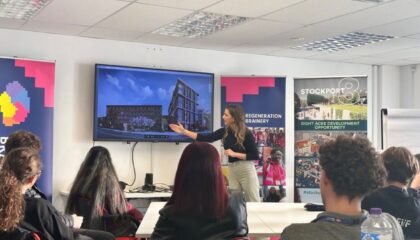
With more and more staff returning to company workspaces for more of the working week, the environments those workplaces offer is more important than ever. Despite the widespread adoption of hybrid working by most office-based employers since the pandemic, the KPMG CEO Outlook survey carried out in September 2023 found 64% of leaders globally, and 63% of those in the UK, predicted a full return to in-office working by 2026.
The annual poll – which surveyed more than 1,300 chief executives of the world’s largest businesses, of whom 150 are in the UK – suggested many executives were increasingly supportive of returning to pre-Covid ways of working, more than three years after the pandemic forced office-based employees to carry out their roles from home.
As employees use their workplaces more, occupiers and landlords will be required to prioritise employee health and create healthier workspaces. For instance, the importance of indoor air quality may have risen significantly among building owners and occupiers. This occurred both during and immediately after the pandemic. However, ensuring good ventilation within the work environment remains an important consideration, along with wider wellbeing concerns.
So, how can smart building solutions create healthier workplaces and increase occupant comfort?
Harness the power of technology for healthier workplaces
Building owners and managers need accurate building data to confidently provide clean environments for building occupants. To achieve this, landlords are leveraging automation technology for healthier workplaces and to optimise commercial building operations. Forward-thinking developments include UV light air purification, touchless access control, and advanced filters in ventilation systems.
The UK government has included proposals on how to improve ventilation in its consultation on the future of building regulations. The plans require offices to use ventilation systems that provide 50% higher rates of fresh air. This surpasses existing minimum standards for air quality. Many offices and building owners have already exceeded building regulation requirements for years.
Smart building solutions for healthier workplaces
Achieving healthier workplaces doesn’t always demand the replacement of HVAC systems, costly building management systems (BMS) or intricate integration with existing control systems. Smart building technology platforms like our IBOS can automate and optimise buildings’ existing ecosystems. This creates intelligent buildings easily and cost effectively.
Through cloud-based Internet of Things (IoT) technology, IBOS monitors building systems, occupier comfort factors, and occupancy data. It offers alerts for air quality, lighting control, heating, and other systems. This complements the significant energy efficiency gains attainable by identifying opportunities to reduce a building’s energy consumption. In installations covering over 5 million square feet of commercial real estate, there has been a noticeable decrease in energy costs. This reduction falls within the range of 20% to 40%. It occurred in less than 12 months of implementing the cloud-based IoT technology.
IBOS offers precise and reliable real-time data, enabling occupiers to monitor temperature and air quality in their own occupied workspace. It creates cleaner air by informing building and facilities managers exactly when to replace air conditioning filters, for example. Instead of a twice-yearly fixed replacement schedule, filters can be replaced as needed. This ranges from once a year to six times.
With a much higher degree of automation and optimisation, IBOS allows building owners to address the issue of office indoor air quality. This takes advantage of technology to measure carbon dioxide and other pollutants, making adjustments as needed. Dirty filters require more energy to push air, while clean filters result in cost and carbon savings.
Optimising ventilation for enhanced building comfort
Increased ventilation levels can benefit different building areas based on CO2 levels. Heating and cooling can also be controlled granularly, considering area-specific usage. By monitoring occupancy levels, which can vary hugely during the week, the predictive building system can optimise ventilation systems according to the level of occupancy, addressing air quality and creating efficiencies when buildings are less occupied.
Healthy workspaces are key to the mental and physical health of employees. Productivity gains can be achieved by programming IBOS IoT sensors to boost fresh air circulation during the post-lunch CO2 peak, avoiding productivity slumps.
Mind the workplace gender data gap
Of course, not all employees are equal. The workplace has a gender data gap. Office temperatures and chemical analysis primarily rely on male data, neglecting female perspectives. The 2019 book, Invisible Women: Exposing Data Bias in a World Design for Men, by Caroline Criado Perez, shows that the formula to determine a standard office temperature was developed in the 1960s around the metabolic resting rate of the average man. A recent Dutch study made an interesting observation. It found that the metabolic rate of young adult females who engage in light office work is considerably lower. This difference exists when compared to the standard values for men engaged in the same activity. In fact, the formula may overestimate female metabolic rate by as much as 35%, meaning that current offices have their HVAC set on average five degrees too cold for women.
These differences also pertain to air quality itself. This is because men and women possess distinct immune systems and hormones, which can influence how chemicals are absorbed in the workspace. Women, typically smaller than men with thinner skin, may have a lower tolerance for toxins.
To create genuinely intelligent, predictive workspaces that operate safely for everyone, organisations should collect data on employees’ needs. This data should encompass a diverse representation of today’s workforce, rather than solely focusing on the male population.
Healthy buildings mean healthy income
In the meantime, building system data afforded by IBOS and its IoT sensors gives landlords better insight into how they can improve the environment and the wellbeing of occupiers. Rules can be set within the system to reduce imbalances across an office, as well as optimising energy use, thereby improving sustainability, while also improving occupant comfort.
There are significant bottom-line gains to be made from using smart building solutions. Buildings certified as healthy attract rents between 4.4% and 7.7% more per square foot than their nearby non-certified peers, according to ‘The Financial Impact of Healthy Buildings‘, research conducted in December 2020 by the MIT Real Estate Innovation Lab. The increased use of health & wellbeing accreditations such as Fitwel and the WELL Building Standard to promote buildings, demonstrate its value to occupiers and their staff.
The premium for healthy workspaces and sustainability is only likely to increase. By deploying technological automation solutions like IBOS that optimise aspects like indoor air-quality, building owners can provide healthier and more attractive workspaces, on-demand.
By Vicky Cotton, ESG Director at Workman and James Hallworth, Partner and Head of Building Technology at Workman.



